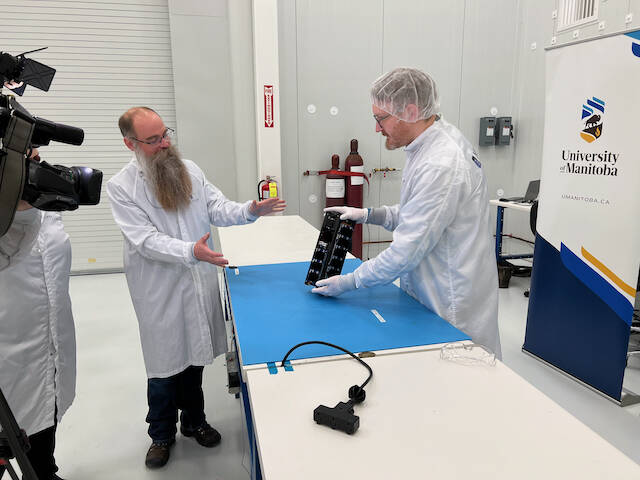‘Great future in space’: U of M research satellite set for launch
Advertisement
Read this article for free:
or
Already have an account? Log in here »
To continue reading, please subscribe:
Monthly Digital Subscription
$0 for the first 4 weeks*
- Enjoy unlimited reading on winnipegfreepress.com
- Read the E-Edition, our digital replica newspaper
- Access News Break, our award-winning app
- Play interactive puzzles
*No charge for 4 weeks then price increases to the regular rate of $19.00 plus GST every four weeks. Offer available to new and qualified returning subscribers only. Cancel any time.
Monthly Digital Subscription
$4.75/week*
- Enjoy unlimited reading on winnipegfreepress.com
- Read the E-Edition, our digital replica newspaper
- Access News Break, our award-winning app
- Play interactive puzzles
*Billed as $19 plus GST every four weeks. Cancel any time.
To continue reading, please subscribe:
Add Free Press access to your Brandon Sun subscription for only an additional
$1 for the first 4 weeks*
*Your next subscription payment will increase by $1.00 and you will be charged $16.99 plus GST for four weeks. After four weeks, your payment will increase to $23.99 plus GST every four weeks.
Read unlimited articles for free today:
or
Already have an account? Log in here »
Hey there, time traveller!
This article was published 03/06/2023 (904 days ago), so information in it may no longer be current.
About 130 students and faculty who will be getting together at the University of Manitoba’s Price Faculty of Engineering on today to watch the launch of their own satellite into space (as long as the weather in south Florida co-operates).
The U of M’s small satellite called Iris — the size of a milk carton — will do experiments to understand the impact space weather has on asteroids and other space material.
It’s part of a Canadian Space Agency program to encourage more research into satellites and space and more space-related industry in Canada.

Philip Ferguson (l) with PhD candidate Morgan May showing off Iris before it was packed away to get ready to be launched into space.
The Canadian CubeSat Project awarded one contract for every province and territory with a few extras so students can participate in a real space mission by designing, building, launching, and operating their own miniature satellite.
About 50 U of M grad students have worked on Iris since the project began in 2018.
The small satellites, called CubeSats, have become a standardized design for economic space missions. They can come in a few different sizes — slightly smaller and larger than a milk carton — and are much more economical than the typical satellites that might cost $100 million or more.
Iris cost about $200,000 to produce with the Canadian Space Agency covering the $250,000 launch cost.
The U of M was uniquely set up to take part in the project since it had already established the Space Technology and Advanced Research Laboratory (STARLab) in 2017 when Philip Ferguson, the project lead and the NSERC/Magellan Aerospace Industrial Research Chair in Satellite Engineering, moved over to the U of M from Magellan Aerospace where he was the engineering manager.
Magellan is one of only two Canadian companies with an extensive track record in the space industry and its association with Ferguson and the U of M has given students access to all sorts of technology and support.
Ferguson said one of the reasons for the low cost is that instead of space quality materials that need to undergo all sorts of quality and testing, the CubeSat uses automotive grade materials.
Ferguson said, “We do analysis to make sure it can survive the launch and thermal conditions of space, but not exhaustive testing. We accept a certain higher level of risk. But because the mission does not take too long, does not cost much to launch and not much to develop we can do a lot more of them.”
The design is being used for all sorts of applications both commercial and research-based. Ferguson said the inexpensive design helps the Canadian Space Agency’s goals to establish some space capabilities at post-secondary institutions across the country.
Ferguson has been involved in a number of space programs both at Magellan and elsewhere and his connection with Magellan has proved to be fortuitous for the U of M.
In addition to the fact that about seven recent mechanical engineering grads have secured work at Magellan over the past few years, his STARLab is tightly linked to industry.
“I have some of their engineers help me teach some classes, in turn we get students into internships at Magellan and full-time jobs,” he said. “We are tightly integrated with the space industry in Canada. That is one of the things that sets my lab apart.”
And in the bigger picture, it is good for the Canadian space industry.
“It’s a perfect way to collaborate,” he said. “It really sets Canada up for a great future in space.”
The satellite is to be launched on a SpaceX Falcon 9 rocket, the model that has proven to be the workhorse for the space industry with up to 90 launches expected this year.
It will take about two days to eventually dock at the International Space Station carrying thousands of pounds of supplies, as well as a couple of other CubeSat satellites from other Canadian universities.
In addition to the U of M students there was also collaborations with York University, the University of Winnipeg, the Interlake School Division and Magellan Aerospace.
Specifically, the satellite was designed to study how space conditions affect the composition of asteroids and the moon so that researchers on Earth can better understand those effects when studying meteorites and to better understand the origins of asteroids.
martin.cash@freepress.mb.ca

